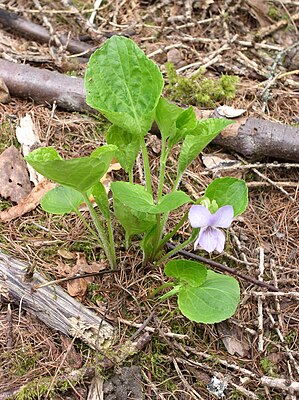Wonder violets
| Wonder violets | ||||||||||||
|---|---|---|---|---|---|---|---|---|---|---|---|---|

Wonder Violet ( Viola mirabilis ) |
||||||||||||
| Systematics | ||||||||||||
|
||||||||||||
| Scientific name | ||||||||||||
| Viola mirabilis | ||||||||||||
| L. |
The miracle violet ( Viola mirabilis ) is a member of the violet family (Violaceae) that occurs scattered in Central Europe . The type epithet mirábilis is of Latin origin from mírári = to wonder. It refers to the peculiarity of the plant that blooming specimens that develop in spring differ markedly from those that bloom in midsummer.
description
The miracle violet is a perennial plant with a thick, brown scaly base axis. It grows herbaceous and reaches heights of between 10 and 25 cm. The quite large leaves are broad, heart-shaped, pointed to a short point and, when young, are rolled up like a bag. The lower ones are almost kidney-shaped and blunt.
The peculiarity of the wonder violet is that its appearance in spring differs significantly from that in midsummer. The spring plant has a leaf rosette with basal , opening, but not fruiting flowers ( chasmogamy ). The midsummer plant, on the other hand, develops more or less upright, single-row hairy, leafy stems. These bear short-stalked, mostly fruity, but not opening flowers ( Kleistogamy ).
The spring flowers reach a length of about 2 cm, are pale purple in color and fragrant. The cleistogamic flowers appearing later, however, are apparently without petals. All flowers have lanceolate stipules and sepals. The fruit capsule is pointed and hairless. The flowering time of the miracle violet includes the spring phase, which usually lasts from April to May, as well as the midsummer period.
The number of chromosomes is 2n = 20.
Distribution and location
The species occurs in Europe. In Asia, their distribution area extends to China, Japan and Far Eastern Russia. It is a Eurasian-continental floral element. In Germany, the miracle violet is mainly found in the limestone regions of Bavaria, Thuringia and Baden-Württemberg. In addition, it is absent over long distances or is rare. Viola mirabilis occurs sparsely in Austria and Switzerland . However, it is also more common in places.
The wonder violet grows in mixed deciduous forests. It prefers more or less fresh, nutrient-rich, calcareous, loose, sometimes stony soils. It is a Querco-Fagetea class character. In the Allgäu Alps, it rises in the Tyrolean part at the entrance of the Kaisertal near Kaisers to an altitude of 1550 meters.
Varieties
There are two varieties:
- Viola mirabilis var. Mirabilis : It occurs in Europe and its range extends in Asia to Central Asia and Siberia.
- Viola mirabilis var. Subglabra Ledeb. : It occurs in Siberia, Mongolia, China, Korea, Japan and in Far Eastern Russia.
photos
literature
- Christian August Friedrich Garcke : Illustrated flora. , Verlag Paul Parey 1972, ISBN 3-4896-8034-0
- Sebald, Seybold, Philippi: The fern and flowering plants of Baden-Württemberg. , Ulmer Verlag, Stuttgart 1990, ISBN 3-8001-3323-7
- Wolfgang Adler, Karl Oswald, Raimund Fischer: Excursion flora of Austria. Ed .: Manfred A. Fischer . Ulmer, Stuttgart / Vienna 1994, ISBN 3-8001-3461-6 .
- August Binz , Christian Heitz: School and excursion flora for Switzerland. , Schwabe & Co. AG, Basel 1986, ISBN 3-7965-0832-4
- Erich Oberdorfer : Plant-sociological excursion flora. , Ulmer Verlag, Stuttgart 1990, ISBN 3-8001-3454-3
Individual evidence
- ↑ a b Erich Oberdorfer : Plant-sociological excursion flora for Germany and neighboring areas . With the collaboration of Angelika Schwabe and Theo Müller. 8th, heavily revised and expanded edition. Eugen Ulmer, Stuttgart (Hohenheim) 2001, ISBN 3-8001-3131-5 , pp. 676 .
- ↑ a b c d Viola in the Germplasm Resources Information Network (GRIN), USDA , ARS , National Genetic Resources Program. National Germplasm Resources Laboratory, Beltsville, Maryland.
- ↑ Erhard Dörr, Wolfgang Lippert : Flora of the Allgäu and its surroundings. Volume 2, IHW, Eching 2004, ISBN 3-930167-61-1 , p. 233.
Web links
- Wonder violets. In: FloraWeb.de.
- Profile and distribution map for Bavaria . In: Botanical Information Hub of Bavaria .
- Wonder violets . In: BiolFlor, the database of biological-ecological characteristics of the flora of Germany.
- Viola mirabilis L. In: Info Flora , the national data and information center for Swiss flora . Retrieved December 25, 2015.
- Distribution in the northern hemisphere according to Eric Hultén
- Thomas Meyer: Data sheet with identification key and photos at Flora-de: Flora von Deutschland (old name of the website: Flowers in Swabia )









